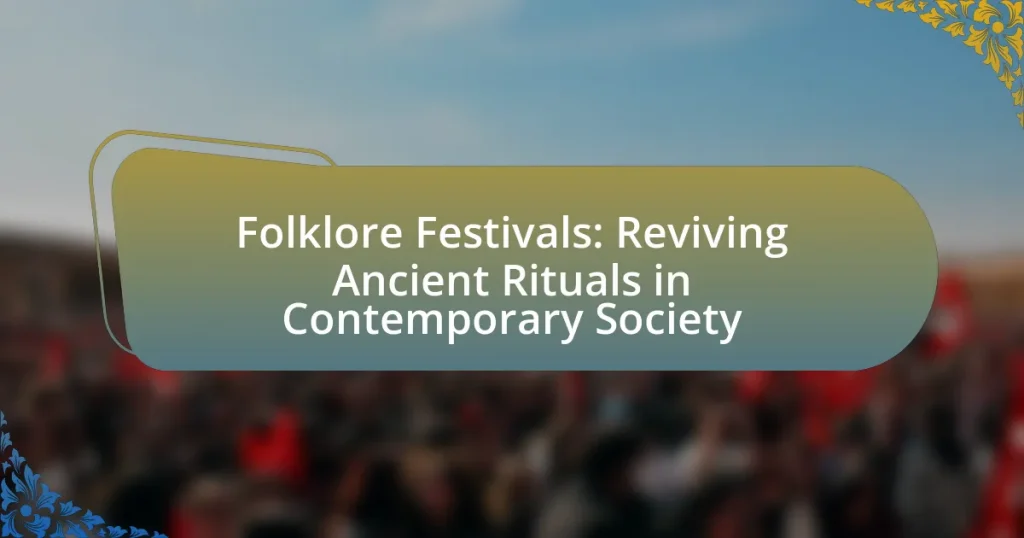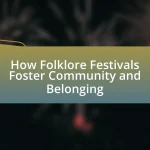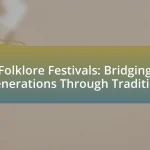Folklore festivals are cultural events that celebrate and preserve the traditional customs, stories, music, dance, and crafts of specific communities or regions. These festivals serve as living archives of cultural heritage, showcasing practices passed down through generations and reinforcing community identity. The article explores the historical context of folklore festivals, their significance in contemporary society, and the various rituals and performances featured. It also examines the impact of globalization and technology on these festivals, highlighting successful examples worldwide and providing practical tips for attendees to enhance their experience.
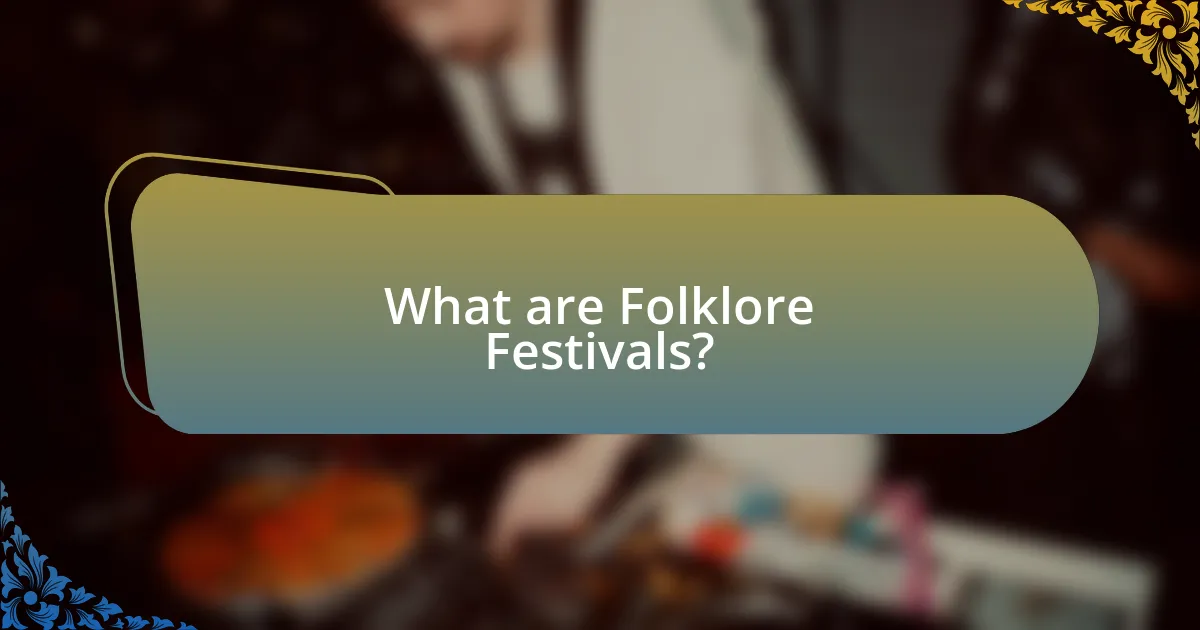
What are Folklore Festivals?
Folklore festivals are cultural events that celebrate and preserve traditional customs, stories, music, dance, and crafts of a community or region. These festivals often feature performances, workshops, and exhibitions that showcase the unique heritage and practices of a specific culture, allowing participants to engage with and learn about their historical roots. For example, the National Folk Festival in the United States highlights diverse folk traditions from various ethnic groups, emphasizing the importance of cultural preservation and community identity.
How do Folklore Festivals reflect cultural heritage?
Folklore festivals reflect cultural heritage by showcasing traditional practices, music, dance, and crafts that have been passed down through generations. These festivals serve as a living archive of a community’s history, identity, and values, allowing participants and audiences to engage with their cultural roots. For instance, events like the National Folk Festival in the United States highlight regional traditions, preserving unique art forms such as Appalachian music and Native American storytelling. By celebrating these elements, folklore festivals reinforce community bonds and promote cultural continuity, ensuring that heritage is not only remembered but actively practiced in contemporary society.
What historical events led to the establishment of Folklore Festivals?
The establishment of Folklore Festivals was significantly influenced by the Romantic movement of the 19th century, which emphasized the importance of national identity and cultural heritage. This movement led to a revival of interest in traditional customs, music, and storytelling as a means to celebrate and preserve local cultures. Additionally, the industrial revolution prompted a shift from rural to urban living, causing a disconnection from traditional practices. As a response, communities began organizing festivals to reconnect with their cultural roots and promote folk traditions. These events often featured music, dance, and crafts, reflecting the unique cultural narratives of various regions, thereby solidifying their role in contemporary society as a means of cultural preservation and celebration.
How do different cultures interpret Folklore Festivals?
Different cultures interpret folklore festivals as vital expressions of their unique identities and traditions. For instance, in Mexico, the Day of the Dead festival emphasizes honoring deceased ancestors, blending indigenous and Catholic beliefs, while in Japan, the Obon festival focuses on welcoming ancestral spirits, showcasing a deep respect for family lineage. These interpretations reflect each culture’s values, beliefs, and historical contexts, demonstrating how folklore festivals serve as a means of cultural preservation and community cohesion.
Why are Folklore Festivals important in contemporary society?
Folklore festivals are important in contemporary society because they serve as vital platforms for cultural preservation and community engagement. These festivals allow diverse communities to showcase their unique traditions, music, dance, and storytelling, fostering a sense of identity and belonging among participants. For instance, events like the National Folk Festival in the United States attract thousands of attendees, highlighting the significance of folk arts in maintaining cultural heritage. Additionally, folklore festivals promote intercultural dialogue by bringing together people from various backgrounds, enhancing social cohesion and understanding. This role in cultural exchange is evidenced by studies showing that participation in such festivals can lead to increased appreciation for cultural diversity and heritage among attendees.
What role do Folklore Festivals play in community bonding?
Folklore festivals play a crucial role in community bonding by fostering social cohesion and cultural identity among participants. These events bring together individuals from diverse backgrounds, encouraging interaction and collaboration through shared traditions, music, dance, and storytelling. Research indicates that such festivals enhance community ties by creating a sense of belonging and collective memory, as seen in studies like “The Role of Festivals in Community Development” by Smith and Jones, which highlights how local festivals strengthen relationships and promote civic pride.
How do Folklore Festivals contribute to cultural preservation?
Folklore festivals contribute to cultural preservation by actively showcasing and revitalizing traditional practices, stories, and art forms that are at risk of being forgotten. These festivals serve as platforms for communities to celebrate their heritage, allowing participants to engage with their cultural identity through music, dance, crafts, and storytelling. For instance, the Smithsonian Folklife Festival has highlighted diverse cultural expressions, helping to document and promote the traditions of various ethnic groups, thereby ensuring their continuity. By fostering intergenerational knowledge transfer, folklore festivals not only preserve cultural elements but also adapt them to contemporary contexts, making them relevant for future generations.
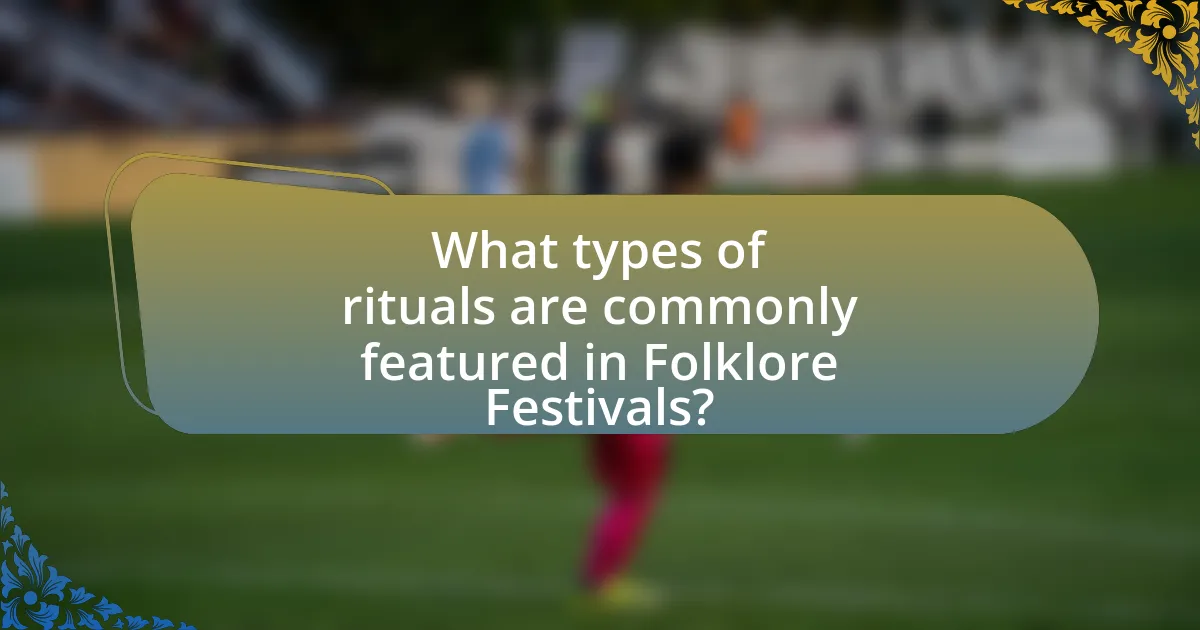
What types of rituals are commonly featured in Folklore Festivals?
Folklore festivals commonly feature rituals such as traditional dances, storytelling, and seasonal celebrations. Traditional dances, often performed in regional costumes, serve to preserve cultural heritage and engage the community. Storytelling rituals, which include folk tales and legends, are integral for passing down history and values. Seasonal celebrations, like harvest festivals, mark significant agricultural events and foster community bonding. These rituals not only celebrate cultural identity but also attract tourism, contributing to local economies and cultural preservation efforts.
How do seasonal changes influence the rituals in Folklore Festivals?
Seasonal changes significantly influence the rituals in Folklore Festivals by dictating the themes, activities, and symbolism associated with each celebration. For instance, spring festivals often celebrate renewal and fertility, featuring rituals like planting and flower offerings, while autumn festivals may focus on harvest and gratitude, incorporating activities such as gathering crops and sharing food. Historical evidence shows that many folklore festivals, such as the harvest festival in various cultures, align with agricultural cycles, reinforcing community bonds and cultural identity. These seasonal adaptations ensure that the rituals remain relevant and resonate with the natural rhythms of life, thereby preserving their significance across generations.
What are some examples of seasonal rituals in different cultures?
Examples of seasonal rituals in different cultures include the Japanese Hanami, where people celebrate the blooming of cherry blossoms in spring, and the Indian festival of Makar Sankranti, which marks the transition of the sun into the zodiac sign of Capricorn and is celebrated with kite flying and feasting. Additionally, the Mexican Día de los Muertos honors deceased loved ones during the fall, while the Scandinavian Midsummer festival celebrates the summer solstice with bonfires and traditional dances. These rituals reflect cultural values and seasonal changes, reinforcing community bonds and traditions.
How do these rituals vary across regions?
Rituals vary across regions due to cultural, historical, and environmental influences. For instance, in Europe, harvest festivals often include communal feasting and traditional dances, reflecting agrarian practices, while in Asia, rituals may incorporate spiritual elements such as offerings to ancestors, showcasing deep-rooted beliefs in filial piety. Additionally, in Africa, rituals often emphasize community bonding through music and storytelling, which are integral to preserving oral traditions. These variations highlight how local customs and societal values shape the expression of rituals, making them unique to each region.
What are the key elements of a Folklore Festival?
The key elements of a Folklore Festival include traditional music, dance performances, storytelling, crafts, and local cuisine. Traditional music and dance performances showcase the cultural heritage and artistic expressions of a community, often featuring instruments and styles unique to the region. Storytelling serves to preserve oral traditions and convey historical narratives, while crafts highlight local artisanship and skills passed down through generations. Local cuisine offers attendees a taste of regional flavors and culinary practices, further enriching the cultural experience. These elements collectively contribute to the festival’s role in celebrating and reviving ancient rituals within contemporary society.
What types of performances are typically showcased?
Folklore festivals typically showcase traditional music, dance, storytelling, and theatrical performances. These performances often reflect the cultural heritage and historical narratives of specific communities, allowing participants to engage with their cultural identity. For instance, traditional folk dances may include regional styles such as the Irish jig or the Spanish flamenco, while storytelling segments often feature myths and legends passed down through generations. The inclusion of these diverse performance types serves to educate audiences about the cultural significance and artistic expressions inherent in folklore, thereby preserving these traditions for future generations.
How do crafts and food play a role in Folklore Festivals?
Crafts and food are integral to folklore festivals as they embody cultural heritage and community identity. Crafts, such as traditional weaving, pottery, and woodworking, showcase local artisanship and preserve age-old techniques, often passed down through generations. Food, including regional dishes and traditional recipes, serves as a medium for cultural expression and communal bonding, allowing participants to experience the flavors of their heritage. For instance, festivals often feature food stalls that highlight local ingredients and cooking methods, reinforcing the connection between the community and its culinary traditions. This interplay of crafts and food not only enriches the festival experience but also fosters a sense of belonging and continuity within the community.
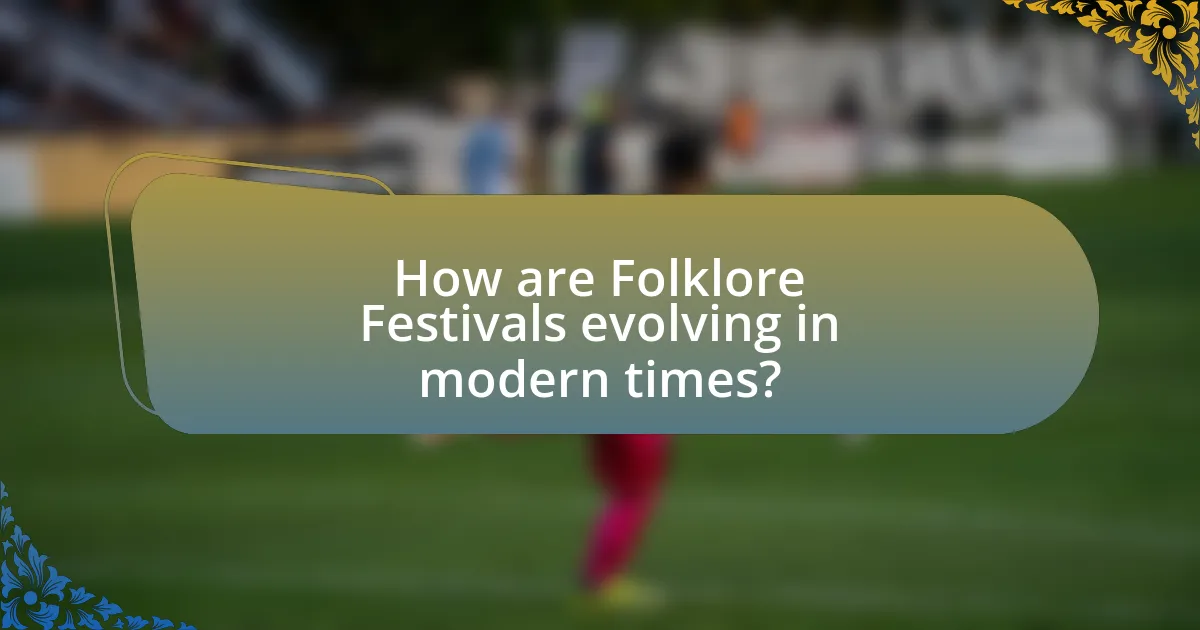
How are Folklore Festivals evolving in modern times?
Folklore festivals are evolving in modern times by integrating contemporary themes, technology, and diverse cultural expressions. These festivals now often feature modern music genres alongside traditional performances, attracting younger audiences and fostering cross-cultural exchanges. For instance, many festivals incorporate digital platforms for promotion and engagement, allowing for virtual participation and broader reach. Additionally, the inclusion of social issues, such as environmental sustainability and social justice, reflects current societal concerns, making these events more relevant to today’s audiences. This evolution is evident in festivals like the Smithsonian Folklife Festival, which adapts its programming to highlight contemporary cultural narratives while preserving traditional practices.
What impact does globalization have on Folklore Festivals?
Globalization significantly influences folklore festivals by promoting cultural exchange and commercialization. As cultures interact more frequently due to globalization, folklore festivals often incorporate diverse elements from various traditions, leading to a blending of cultural practices. This can enhance the visibility and appreciation of local traditions but may also dilute their authenticity. For instance, festivals may adapt to attract international tourists, prioritizing entertainment over traditional practices. Research indicates that in regions like Europe, the commercialization of folklore festivals has increased, with many events now featuring global music and dance styles alongside local heritage, which can shift the focus from preserving cultural identity to maximizing economic gain.
How are traditional practices being adapted for contemporary audiences?
Traditional practices are being adapted for contemporary audiences through the integration of modern technology and interactive elements. For instance, folklore festivals now utilize social media platforms to promote events and engage younger generations, making ancient rituals more accessible and relatable. Additionally, many festivals incorporate contemporary art forms, such as music and dance, to reinterpret traditional narratives, thereby attracting diverse audiences. Research indicates that these adaptations not only preserve cultural heritage but also enhance community participation, as seen in events like the Edinburgh Festival Fringe, which blends traditional storytelling with modern performance techniques.
What challenges do Folklore Festivals face in maintaining authenticity?
Folklore festivals face significant challenges in maintaining authenticity due to commercialization, cultural dilution, and the evolving nature of traditions. Commercialization often leads to the prioritization of entertainment value over genuine cultural expression, resulting in performances that cater to tourist expectations rather than preserving original practices. Cultural dilution occurs when traditional elements are altered or simplified to appeal to broader audiences, which can distort the original meanings and significance of the rituals. Additionally, as societies evolve, the relevance of certain traditions may diminish, leading to adaptations that stray from their authentic roots. These factors collectively threaten the integrity of folklore festivals, making it difficult to present an accurate representation of cultural heritage.
How do technology and social media influence Folklore Festivals?
Technology and social media significantly influence folklore festivals by enhancing visibility, engagement, and participation. Social media platforms allow festival organizers to reach broader audiences, facilitating real-time updates and interactions that attract more attendees. For instance, festivals like the National Folk Festival in Australia utilize Facebook and Instagram to share live performances and behind-the-scenes content, increasing audience engagement and interest. Additionally, technology enables the documentation and preservation of folklore traditions through digital archiving, ensuring that cultural practices are recorded and accessible for future generations. This integration of technology not only revitalizes interest in traditional practices but also fosters a sense of community among participants, as seen in the growing online discussions surrounding events.
What are the benefits of using social media for promoting Folklore Festivals?
Using social media to promote Folklore Festivals significantly enhances visibility and engagement. Social media platforms allow festival organizers to reach a broader audience, facilitating real-time interaction and sharing of content related to the festival. For instance, a study by the Pew Research Center indicates that 72% of adults use at least one social media platform, providing a vast potential audience for festival promotion. Additionally, social media enables targeted advertising, allowing organizers to reach specific demographics interested in cultural events, thus increasing attendance. Furthermore, user-generated content, such as photos and videos shared by attendees, can create a sense of community and excitement around the festival, further driving interest and participation.
How does technology enhance the festival experience for attendees?
Technology enhances the festival experience for attendees by providing interactive platforms and real-time information. For instance, mobile apps allow attendees to access schedules, maps, and artist information instantly, improving navigation and engagement. Additionally, social media integration enables participants to share their experiences live, fostering a sense of community and connection. Data from a 2022 survey by Eventbrite indicated that 70% of festival-goers preferred events that utilized technology for enhanced interactivity and convenience. This integration of technology not only streamlines the attendee experience but also enriches the overall atmosphere of folklore festivals, making ancient rituals more accessible and engaging in a contemporary context.
What are some successful examples of Folklore Festivals worldwide?
Some successful examples of folklore festivals worldwide include the National Folk Festival in the United States, the Festival of American Folklife, and the International Folklore Festival in Romania. The National Folk Festival, held annually in various locations since 1934, showcases diverse cultural traditions through music, dance, and crafts, attracting thousands of visitors each year. The Festival of American Folklife, organized by the Smithsonian Institution, celebrates the cultural heritage of various communities and features performances, workshops, and exhibitions. The International Folklore Festival in Romania, which takes place in various cities, highlights traditional music and dance from around the world, promoting cultural exchange and understanding. These festivals successfully preserve and promote folklore, engaging audiences and fostering community connections.
What unique features set these festivals apart?
Folklore festivals are distinguished by their integration of ancient rituals, community participation, and cultural storytelling. These festivals often feature traditional music, dance, and crafts that reflect the heritage of the community, creating an immersive experience for attendees. For example, the celebration of harvest festivals typically includes rituals that honor agricultural cycles, showcasing local customs and practices that have been passed down through generations. Additionally, many folklore festivals incorporate interactive elements, such as workshops and performances, allowing participants to engage directly with the cultural traditions being celebrated. This combination of historical significance and active involvement sets these festivals apart from other cultural events.
How do these festivals attract international visitors?
Folklore festivals attract international visitors through unique cultural experiences, showcasing traditional music, dance, and rituals that resonate globally. These festivals often feature authentic performances and workshops that allow attendees to engage with local customs, fostering a sense of connection and curiosity. For instance, events like the International Folklore Festival in Bulgaria draw thousands of participants from various countries, highlighting the universal appeal of cultural heritage. Additionally, marketing strategies that emphasize the festivals’ historical significance and vibrant atmospheres further enhance their attractiveness to a global audience.
What practical tips can enhance the experience of attending a Folklore Festival?
To enhance the experience of attending a Folklore Festival, attendees should plan their visit by researching the festival schedule and key performances in advance. This preparation allows individuals to prioritize must-see events, ensuring they do not miss significant cultural displays. Additionally, engaging with local artisans and performers can deepen understanding and appreciation of the traditions being showcased, as many festivals feature workshops and demonstrations that provide hands-on experiences. Staying hydrated and wearing comfortable clothing is essential, as festivals often involve extensive walking and outdoor activities. Furthermore, participating in community activities, such as traditional dances or storytelling sessions, fosters a sense of connection with the culture being celebrated. These practical tips are supported by the fact that active participation and preparation significantly enhance cultural immersion, as evidenced by studies on audience engagement in cultural events.
How can attendees prepare for a Folklore Festival?
Attendees can prepare for a Folklore Festival by researching the specific traditions and events featured at the festival. Understanding the cultural significance of the performances, crafts, and food can enhance the experience. For instance, many folklore festivals include workshops, storytelling sessions, and traditional music, which attendees can participate in or observe to gain deeper insights into the culture being represented. Additionally, checking the festival schedule in advance allows attendees to plan their visit around key events, ensuring they do not miss important performances or activities.
What should visitors know about local customs and etiquette?
Visitors should know that local customs and etiquette during folklore festivals often emphasize respect for traditions and community participation. Engaging with local rituals, such as dressing in traditional attire or participating in dances, is encouraged to honor the cultural significance of the event. Additionally, visitors should be mindful of personal space and avoid disruptive behavior, as many festivals are rooted in deep historical and spiritual meanings. For instance, in many cultures, it is customary to greet elders first and to express gratitude for hospitality, reflecting the community’s values of respect and appreciation.










